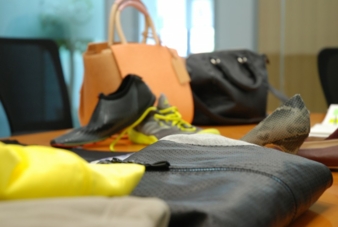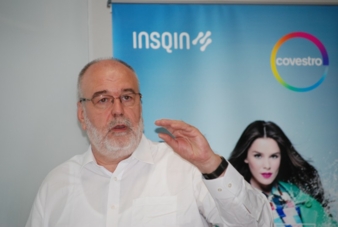21/01/2016 — auf Deutsch lesen
Covestro: And then came polyurethane
Until the early 1940s, the fashion and footwear industries were reliant on leather when producing high quality products. Availability was limited, however, and quality depended on how the animals had been reared and kept. And then polyurethane as a coating for textiles came into fashion.
Not only did polyurethane (PU) coatings allow synthetic leathers to be produced – they had additional positive properties that opened up a far broader range of applications. Their water-repellent and moisture-permeable properties, for instance, meant that PU-coated textiles could, and can, be used in fashion for outdoor clothing, sports shoes and transfers for T-shirt printing. But they have also found their way into blackout fabrics, tarpaulins and other technical textiles.
The most important buyers of synthetic leather continue to be the fashion and footwear industries. Both are able to take advantage not only of its functionality but also of the unlimited range of design opportunities offered by PU-coated fabrics. Surface structure, elasticity, handle and drape properties, colours and visual special effects are easy to control, thanks to the material's production processes, creating the conditions necessary for the frequent collection changes that are common in the fashion industry. This high degree of flexibility is reflected in the global use of PU-coated textiles: every year, eight billion pairs of shoes (including a billion pairs of sports shoes), two billion bags and a billion outdoor jackets and fashionable outerwear are produced from PU-coated fabrics.
Hitherto, however, manufacturers and producers have had to put up with one flaw: the production of PU coatings requires the use of the solvent dimethylformamide (DMF), which is rated in the REACH chemical classification as a 'substance of high concern'. The current production process, therefore, cannot be reconciled with the sustainability requirements of the outdoor industry and of various leading fashion brands. In 2014 Covestro, formerly known as Bayer MaterialScience and responsible for the discovery of polyurethane, closed this ecological gap with its INSQIN technology. The company, which has its headquarters in Leverkusen, Germany, has developed a water-based PU coating that allows a fully solvent-free production process without affecting the product's properties. This new technology is marketed through Covestro Shanghai, where the Textiles Coating division has its development centre and global management team.
The water-based PU coatings can be used both in the transfer (or reverse) coating process and for direct coating. The solvent-free transfer process relies on the creation of a coating film which is then attached to the textile. As a first step, a compact polyurethane skin layer is applied to a special paper which later transfers its surface texture – that of cowhide, for example – to the fabric. Once it has dried, a second, more voluminous PU-[RI] foam coating is applied (the foam or intermediate layer). This, too, is dried and an adhesive is then applied to it which creates the bond with the textile. The adhesive can be activated in its pre-dried state by heat, and then bonded to the fabric. Alternatively, the bonding material used to attach the PU coating to the textile can also be used wet, in which case the term 'wet lamination' is used.
To bond the two elements together, the textile is brought into contact with the PU film on its paper carrier and then pressed and dried. The carrier paper is then removed, leaving the desired surface texture behind. This transfer process is used primarily for the manufacture of PU synthetic leather for clothing and footwear uppers, says Rolf Irnich, Director, Technical Development Global Textiles at Covestro: "The reverse process will always be chosen if either the substrate will not permit direct coating (elastic materials, fleece, knitted fabrics) and/or if a particular surface texture (leather grain, textile character, high gloss) or special effect (two-colour effect, holographic effect) is being sought. Wet lamination is preferred for footwear uppers because it provides better adhesion, but its handle is always somewhat stiffer than with dry lamination. For items of clothing, the need for adhesion is generally less demanding – the focus here is more on a softer handle. When making synthetic PU leather for clothing, therefore, dry lamination is the preferred process."
Unlike the reverse process, the direct coating process avoids such circuitous routes. The PU skin layer is applied direct to the textile and then dried. "This process has benefits in terms of manufacturing costs, as no adhesive layer or carrier paper is required. Typically, it is used when applying functional coatings (waterproofing, windproofing, breathable coating)," explains Irnich. "Fabrics coated using this process go into the production of outdoor clothing and protective workwear," he continues. "The direct coating process has been further developed for the production of synthetic PU leather for clothing, belts and gloves. Here the watery PU foam is applied direct to the fabric; once it has dried, a cover layer is applied and a pattern embossed on this after a final drying."
The design of a water-based polyurethane coating product is not Covestro's only innovation, however. The new product group is also supported by a special marketing concept, the voluntary INSQIN Partner Manufacturing Programme. Its objective is to establish solvent-free PU-coated textiles as a strong brand with fabric manufacturers and clothing and footwear producers, bringing together responsible production operations and brands with high sustainability standards. To participate in the INSQIN Partner Manufacturer Programme, the coating operation have to be audited in advance by the Veritas organisation. This independent institute established by Covestro conducts annual monitoring to ensure that the partners meet the catalogue of sustainability criteria governing the Partner Programme.
[Sabine Anton-Katzenbach]
In the next edition 3-4/2016: Kunshan Xiefu New Material – a coating company from the Kunshan region and leading exporter of synthetic leathers





